
Class 9600 No.39679
at Oiwake depot on the Muroran line.
During Mar 1976.
Japanese
|
1913 - 1976 A middle sized Tender-Engine for sub-main and branch line freight trains. The 9600 was the oldest engine during steams last years. |

Class 9600 No.39679 at Oiwake depot on the Muroran line. During Mar 1976. |
|
At the onset of the 20th century, the Ministry of Railroads formulated plans in regard to standardization, and quantity of new locomotives.
This made the principle from which mass produced domestic standard models emerged. In 1913, the first domestic standard mass-produced model 9600 came on the scene which was in line with the above basic policy. The 9600 was produced from the basic 2-8-0's class 9000, 9150, 9200 and the 2-8-2's class 9700 design. A total of 770 (*) were manufactured during the 14 years from 1913. This was the second largest model manufactured of all Japanese steam engines. (* JGR - 770, Karafuto R. - 14, Taiwan R. - 39, Private R. - 5, Total - 828) The first 9600 was manufactured at the Kawasaki Zosen-jyo Co. it's manufactured number was 73 during 1913, but later she was transferred to China during 1938 and never returned.
During 1919, a more powerful freight engine made its appearance with the class D50. The 9600 was gradually moved to sub-main and branch lines. During 1928-1936, 14 9600s were ordered from Karafuto Railway (currently South-Sakhalin in Russian territory.) as a Karafuto Railway's Class 80 No.80-88 (1928-1936), and Class D50 No.1-5 (1936-1940). When the Karafuto railway was integrated with the Japanese government railway during 1943, they were transferred to the JGR and renumbered with the ensuing JGR 9600's No. 79670 - 79674 (D50-1 to 5) and 79680 - 79688 (No.80 to 88). During 1944, six 9600s were transferred from the Japanese mainland to the to the Karafuto Railway. Karafuto Railway ordered 14 and transferred 6 for a total of 20 9600s and were lost at the wars end. A total of 251 9600's representing 32 % were moved out to China. Their gauge was converted from the Japanese Standard Gauge 1067mm 3ft - 6 inch, to 1435mm 4ft - 8.5 inch Continent Standard Gauge. They all didn't return to Japan, but nearly 100 were used continuously on the China Railway after WW2. Of these, a few 9600s were used up to the 1980s in China. After the war, the more modern engine D51 spread on to sub-main line operations. Therefore, the 9600 moved to local lines and yard work. In the 1960's, JNR began replacing the 50 year old 9600. Yet, many of the 9600's were still in active service during the 1960s. The reason, was that there was no proper replacement model. The class C58 did not have enough power from the 9600, but class D60 and D61 were too big for branch lines. Therefore, a few replacement plans were examined. For example, increase remodeling of the more light D61, and produce a new product, the class C63 .... etc. But these plans were rejected due to the progress of electrification and dieselization. After WW2, a total of 507 9600s survived by 1946, and continued up to 1966, with a decrease in numbers to that of 382. 124 engines were still active even in 1974. Other than 9600, all steam locomotives disappeared by the year of 1975, yet, 66 9600s were still enrolled in Hokkaido. But, 19 of them were already retired and waiting to be scrapped. And 47 were operated in yard work and a few local freight train services during early 1975. They were : 7 in the Wakkanai depot (No.19661, 29607, 29613, 29675, 39655, 49603 and 49673) for Soya, Tempoku, Northern-Kohin line, .......Service closed Jul 1975. 9 in the Nayoro depot (No.19640, 39628, 39679, 49644, 49648, 49651, 59659, 59691 and 79642) for the Nayoro Syokotsu, Shinmei line, ........Service closed May 1975. 4 in the Kitami depot (No.29657, 29694, 49616 and 69624) for the Sekihoku, Aioi line, ........ Service closed Jul 1975. 5 in the Engaru depot (No.19680, 49666, 69620, 69625 and 69644) for the Nayoro, Sekihoku, Yumo line, ........ Service closed May 1975. 2 in the Obihiro depot (No.9654 and 19671) for the Hiroo and Shihoro line, ........ Service closed May 1975. 7 in the Iwamizawa depot (No.19603, 29622, 39696, 49615, 59609, 59610 and 69690) for the Iwamizawa area shunting operations, ........ Service closed Dec 1975. 6 in the Takigawa depot (No.19667, 29601, 49612, 59614, 59669 and 69658) for the Horonai, Nemuro (Takigawa-Ashibetsu) line and Takigawa area shunting operations, ........ Service closed Dec 1975. 4 in the Oiwake depot (No.19650, 19673 39697 and 79616) for the Yubari line, and Oiwake area shunting operations, 3 in the Washibetsu depot (No.9644 59613 and 79602) for the Muroran area shunting operations, ....... Service closed Dec 1975. Definitely, the 9600 survived until the end of steam during Mar 1976, despite her 60 year old age. The last 9600s were Oiwake depot's three (No.39679, 49648 and 79602). More details are mentioned on this website " The Last days of Japanese Steam Engines Part 4" pages. |
| Primary ran line in last 10 years |
Soya, Yubari, Hakodate, Yonesaka, Takayama, Miyazu, Kawagoe, Hatiko, Tagawa, Gotoji line etc ...
| Last line/depot and year |
Oiwake depot Mar.1976
| Restored engine (2017) |
none
| Preserved engine (2017) |
41
| |

|
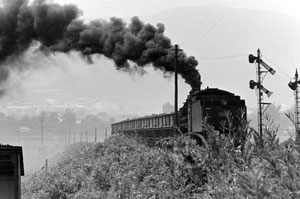
| ||||||||
|
Deepening fall with the splender of its color, Class 9600 departs Tenoko station on Yonesaka line. Nov 1971. |
No.59664 seen here in a "Turned Head " mode, pulling coal cars on a scorching hot day in August. Yusubaru Tagawa line. Aug 1972..
| 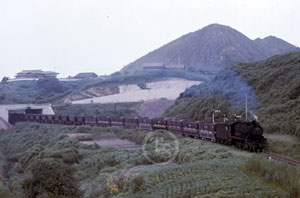
| 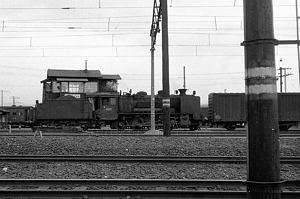
No.29695 is seen here | in northern Kyushu's coal producing area. Gotoji Aug 1974.
Yard work at Takasaki yard No.19619 | Nov 1968.
| 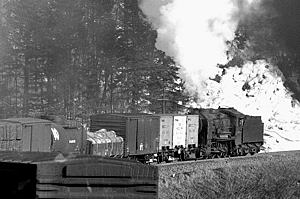
| 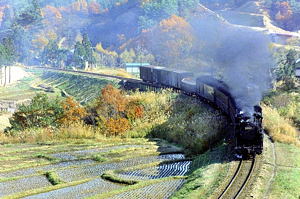
D51_1009 with banker 9600. | Sekihoku pass Mar 1971.
No.29668 at Tenoko, Yonesaka line | Nov 1971. |
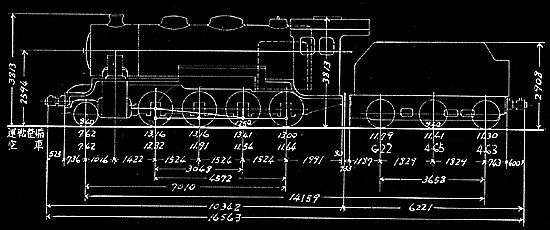
| Configuration | 2-8-0 | Dimensions Length (mm) | 16563 |
| Engine Weight (Operating tons) | 60.4 | Driver size (mm diameter) | 1250 |
| Boiler pressure (Kg/cm2) | 13.0 | Max Tractive effort (tons) | 13.2 |
| Driver Max Power (PS) | 870 | Max Speed (km/h) | 65 |
| Manufactured years | 1913-1926 | Total production | 770 |
| Number of moved out to other countries in WW2 with gauge remodeling. | 269 | Gauge | 3ft 6in (1067mm) |
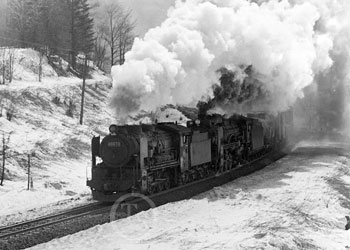
|
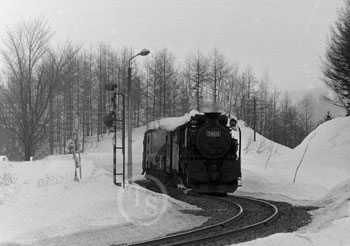
|
Shown here 79673 and D51_398 double-header at Sekihoku pass.Mar.1971 | This unusual photo shows Class 9600, No.79616 running with two lights on Iwanai line. Kozawa 1970 Mar. |
Introduction |
Go to Top |